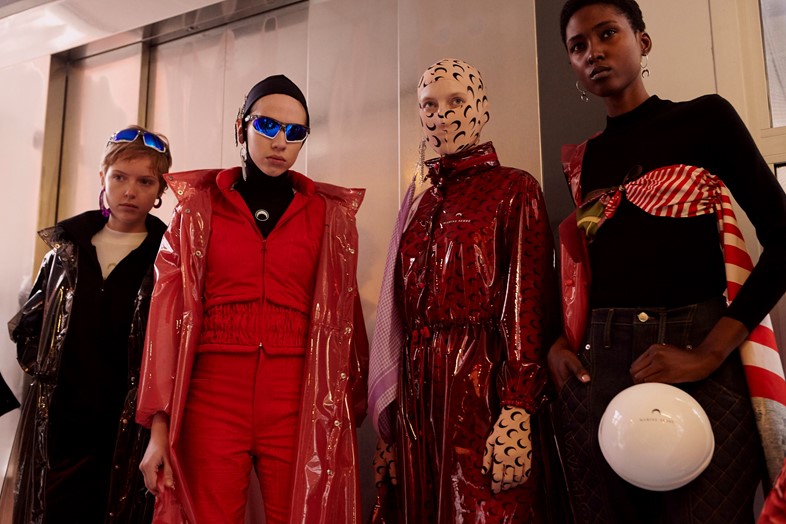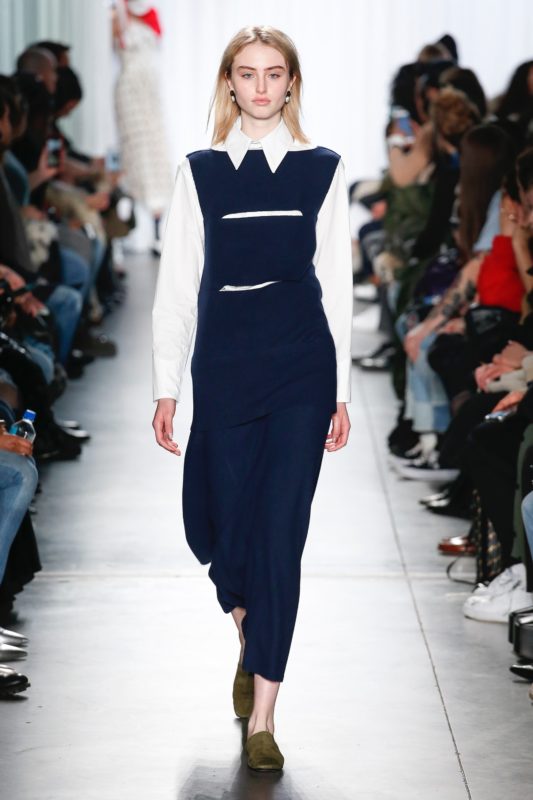There is nothing more uncool right now than a plunging neckline. Showing a bit of cleavage has become the antithesis to any ‘woke’ woman post #MeToo, which is – I guess – simply too bad for the larger-chested women, for whom a high neckline remains uniquely unflattering.

And in the fashion industry itself, there is little suggestion of sex either. Amongst sexual harassment allegations, the abuse of models and the questionable road toward sexualised imagery, the industry has become wary of any insinuation of sex, as if it were almost scared of the idea.
So much of the clothing on display at the AW18 Fashion Month was reserved beyond the usual norms; Gucci presented over 50 looks featuring headwraps, hats or headscarves, triggering calls that fashion was fetishising the hijab. That the industry is treading carefully is understandable; how can provocative photoshoots and racey dressing be navigated against a backdrop of women increasingly speaking out against being objectified and sexualised? The amplification of sexual attraction, which for so long has gone hand-in-hand with the industry, seems outdated and irresponsible.
Given how fashion necessarily engages with pressing cultural topics – from women’s health to immigration – you can understand why, post #MeToo, this season was marked by almost aggressively non-provocative trends. But does a renewed appreciation of more restrained styles mean that those more typically or obviously ‘sexy’ are any less-than? Must we all now favour a more covered-up aesthetic in the name of solidarity, even if a high-necked smock dress looks hideous on those of us over a size 12 and the age of 22?
To attack midi-length skirts and their wearers would be ridiculous, but there is something backward in ruling out the traditional avenue of sexiness, even if it fits the ‘male gaze’ rhetoric we’re trying to move away from. I’m not suggesting that low cut tops and heels are the only way a woman can feel sexy and empowered, but what if you happen to like the bodycon/heeled variety of dressing? It’s surely hypocritical of us to rule out stripper heels and plunging necklines in the name of feminism?
I have an issue with that sort of sanitised mentality and it’s not simply because I think women should be able to do – and by extension dress – as they please. That hackneyed response is no longer very helpful in the current climate of consequence and responsibility, but I do think it’s necessary to question declaring yourself ‘better than’ based on the amount of fabric you choose to clothe yourself in. After all, wasn’t one of the major points that came out of the #MeToo movement that women should not have to police the boundaries or appropriateness or be held responsible for men’s misreading of their cues? That of course, must include the way we choose to dress. I worry that, post #MeToo, we are heading towards a hyper-vanilla version of sex and of fashion where the ‘sophisticated’ take it upon themselves to police and judge the ‘less enlightened.’

We’ve seen it with the demise of the scantily clad booth babes, darts girls and grid girls, who are – apparently – no longer in keeping with ‘brand values.’ Surely it’s no surprise to us that some women rely on and, more to the point, enjoy the sort of jobs that include wearing see-through outfits and matching underwear. I don’t particularly like the idea of being a grid girl myself, but does that mean we must all clutch at our pearls in cries of ‘decency?’ God no. I respect women who choose these jobs over the lesser paid and much less exciting waitressing slog.
And so it should be with fashion. No doubt a pair of palazzo pants and loafers are more practical than a barely-there dress, but modest dressing has become less about practicality and more of an elitist project, used to position oneself amongst those sophisticated and enlightened enough to get it, and above those who need ‘re-educating.’ This kind of better-than-thou fashion isn’t doing anything helpful to add to the conversations surrounding feminism, choice and equality, it’s taking away from them.

The hypocrisy of educated, open-minded ‘feminists’ modesty-shaming other women came to somewhat of a public head in February when Jenifer Lawrence chose to go coatless for a photo taken to promote her new movie Red Sparrow. The photograph was taken in London, during peak winter, which is to say that it was very cold. Lawrence’s male co-stars were bundled in coats but the actress chose to wear a beautiful and sexy Versace dress. Journalist Helen Lewis tweeted: “This is such a quietly depressing (and revealing) image. Not least because I’ve been outside today and it’s bloody FREEZING.”
The tweet was (unsurprisingly) retweeted thousands of times: a picture of a surely-freezing young woman in a skimpy dress surrounded by sensibly-dressed middle-aged men was a pertinent symbol of an industry still racked by a gross power imbalance, months after Weinstein. But those quick to criticize J-Law, spouting ‘feminism’ in their disapproval, entirely missed the point. The actress responded to the conversation on Facebook, calling out anyone accusing her of being unfeminist. Lawrence wrote:
“That Versace dress was fabulous, you think I’m going to cover that gorgeous dress up with a coat and a scarf? I was outside for 5 minutes. I would have stood in the snow for that dress because I love fashion and that was my choice… This is sexist, this is ridiculous, this is not feminism … Everything you see me wear is my choice. And if I want to be cold THAT’S MY CHOICE TOO!”
That’s not to say that just because a woman chooses to do something it is feminist, but I don’t think that everything a woman chooses to do has to be informed by feminism. That we have a choice between the sausage-casing variety of dresses and sack-like silhouettes is the point. Take that choice away via down-the-nose censorship, and we may as well be moving back 100 years.
And as for miniskirts in the #MeToo era? People are not sexually assaulted or harassed based on hemlines and necklines, they are assaulted or harassed because there are those out there that think it’s okay to help themselves to whoever they fancy. The solution isn’t to wear figure-obscuring clothes as a kind of armour, but for predators to learn how to behave and take cue of the clear difference between short skirt and sexual invitation. In short, wear what you want and watch your gaze.
What do you think about the current conservative trends in fashion? Comment below!









